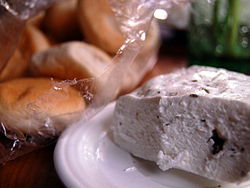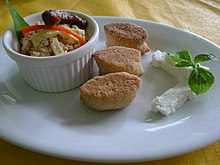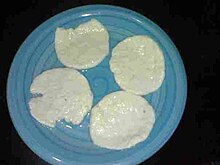
Mozzarella is a southern Italian semi-soft, non-aged cheese traditionally made from Italian buffalo's milk by the pasta filata method.

Rennet is a complex set of enzymes produced in the stomachs of ruminant mammals. Chymosin, its key component, is a protease enzyme that curdles the casein in milk. In addition to chymosin, rennet contains other enzymes, such as pepsin and a lipase.

Cottage cheese, also known as curds and whey, is a curdled milk product with a mild flavor and a creamy, heterogenous, soupy texture. It is made from skimmed milk by draining curds but retaining some of the whey and keeping the curds loose. An essential step in the manufacturing process distinguishing cottage cheese from other fresh cheeses is the addition of a "dressing" to the curd grains, usually cream, which is mainly responsible for the taste of the product. Cottage cheese is not aged.

Curd is obtained by coagulating milk in a sequential process called curdling. It can be a final dairy product or the first stage in cheesemaking. The coagulation can be caused by adding rennet, a culture, or any edible acidic substance such as lemon juice or vinegar, and then allowing it to coagulate. The increased acidity causes the milk proteins (casein) to tangle into solid masses, or curds. Milk that has been left to sour will also naturally produce curds, and sour milk cheeses are produced this way. Producing cheese curds is one of the first steps in cheesemaking; the curds are pressed and drained to varying amounts for different styles of cheese and different secondary agents are introduced before the desired aging finishes the cheese. The remaining liquid, which contains only whey proteins, is the whey. In cow's milk, 90 percent of the proteins are caseins. Curds can be used in baking or may be consumed as a snack.

Mizithra or myzithra is a Greek whey cheese or mixed milk-whey cheese from sheep or goats, or both. It is sold both as a fresh cheese, similar to Italian ricotta, and as a salt-dried grating cheese, similar to Italian ricotta salata. The ratio of milk to whey usually is 7 to 3.

Goat cheese, goat's cheese, or chèvre is cheese made from goat's milk. Goats were among the first animals to be domesticated for producing food. Goat cheese is made around the world with a variety of recipes, giving many different styles of cheeses, from fresh and soft to aged and hard.
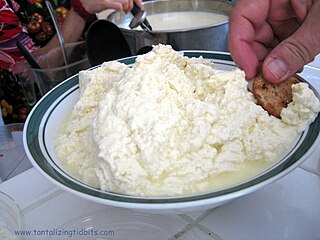
Ricotta is an Italian whey cheese made from sheep, cow, goat, or Italian water buffalo milk whey left over from the production of other cheeses. Like other whey cheeses, it is made by coagulating the proteins that remain after the casein has been used to make cheese, notably albumin and globulin.

Paneer, also known as ponir, is a fresh acid-set cheese common in cuisine of the Indian subcontinent made from full-fat buffalo milk or cow milk. It is a non-aged, non-melting soft cheese made by curdling milk with a fruit- or vegetable-derived acid, such as lemon juice.

Kasseri or Kaşar is a medium-hard or hard pale yellow cheese made from pasteurised or unpasteurised sheep milk and at most 20% goat's milk. "Kasseri" is a protected designation of origin, according to which the cheese must be made in the Greek provinces of Thessaly, Macedonia, Lesbos, or Xanthi, but a similar type of cheese is found in Turkey, Romania, and the Balkans, where it is known as kashkaval. The same cheese is made with cow's milk, but in that case it cannot be legally sold as "kasseri" in the EU and is instead sold under names that are particular to each producer.

Burrata is an Italian cow milk cheese made from mozzarella and cream. The outer casing is solid cheese, while the inside contains stracciatella and clotted cream, giving it an unusual, soft texture. It is typical of Puglia.

Oaxaca cheese, also known as quesillo and queso de hebra, is a white, semihard, low-fat cheese that originated in Mexico. It is similar to unaged Monterey Jack, but with a texture similar to mozzarella or string cheese.

Queso blanco, literally 'white cheese' or queso fresco in Spanish, can refer to many different kinds of cheeses whose only common trait is their white color. The specific cheese referred to depends on the region.

Fermented tofu is a Chinese condiment consisting of a form of processed, preserved tofu used in East Asian cuisine. The ingredients typically are soybeans, salt, rice wine and sesame oil or vinegar. In mainland China the product is often freshly distributed. In overseas Chinese communities living in Southeast Asia, commercially packaged versions are often sold in jars containing blocks 2- to 4-cm square by 1 to 2 cm thick soaked in brine with select flavorings.
Quesillo refers to different Latin American, Spanish, and Filipino foods or dishes depending on the country:
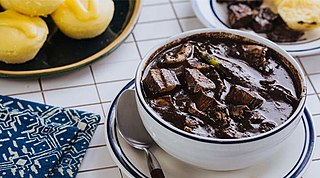
Dinuguan is a Filipino savory stew usually of pork offal and/or meat simmered in a rich, spicy dark gravy of pig blood, garlic, chili, and vinegar.

Cheese is a dairy product produced in wide ranges of flavors, textures, and forms by coagulation of the milk protein casein. It comprises proteins and fat from milk. During production, milk is usually acidified and either the enzymes of rennet or bacterial enzymes with similar activity are added to cause the casein to coagulate. The solid curds are then separated from the liquid whey and pressed into finished cheese. Some cheeses have aromatic molds on the rind, the outer layer, or throughout.

Beyaz peynir is a brine cheese produced from unpasteurized sheep, cow or goat milk. The cheese has a slightly grainy appearance and is similar to lighvan, feta, sirene and other Balkan white cheeses. Vegetable rennet is added to the sheep's milk as a clotting agent. Once the curds are produced, they are pressed, chopped, and strained before being cut into blocks that are salted and placed in a brine solution for approximately six months.
Alpujarras cheese is a Spanish cheese from the eastern region of Andalusia, which includes the provinces of Granada, Almería and the Penibética mountain chain. The cheese takes its name from La Alpujarra, a mountainous region which occupies a part of southern Granada province and western Almeria province. This area has a long history and tradition of goatherding. Alpujarras cheese is made from the milk of the White Andalusian domesticated goat.
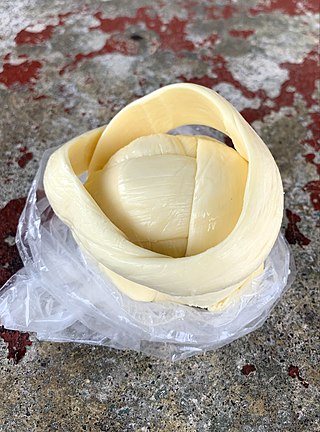
Palmito cheese is a popular fresh cheese from Costa Rica that resembles a knotted ball of string cheese. It has been described as light, salty, and stringy with a texture comparable to mozzarella cheese. It is similar to Oaxaca cheese in Mexico and quesillo in Nicaragua. It is a type of stretched-curd cheese made by using the pasta filata technique. It is thought that the technology to produce the cheese came from Italian immigrants. At an expo in Zarcero in 2007, a 132 kg ball of palmito cheese was created by local cheesemakers.
